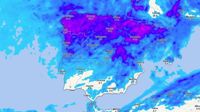On Saturday, May 10, 2025, Spain is bracing for a challenging day as ten communities are placed under alert for severe storms, according to the State Meteorological Agency (AEMET). The forecast indicates a significant deterioration in weather conditions, with expectations of heavy rainfall, thunderstorms, and even hail across various regions of the country.
The AEMET has confirmed that a DANA (Isolated Depression at High Levels) will hover over the northwest peninsula, leading to cloudy skies and showers throughout much of the Peninsula. Initial scattered rains are expected to affect the center and northern parts of the country from early morning, but the situation is set to escalate in the afternoon.
As the day progresses, storms are predicted to intensify, particularly impacting the northern half and eastern third of the Peninsula. The AEMET warns that precipitation could reach alarming levels, with accumulations exceeding 20-30 liters per square meter in just one hour during peak storm conditions.
In total, 24 provinces will be under alerts for rains and storms, with six of these regions receiving orange warnings due to the high risk of severe weather. Areas such as Huesca, Zaragoza, Cuenca, Valencia, central Navarra, and the Ribera del Ebro in both Navarra and La Rioja are particularly at risk.
Meanwhile, yellow warnings have been issued for regions including Almería, Teruel, Burgos, Soria, Albacete, Guadalajara, Tarragona, and various parts of Murcia, the Basque Country, and the Valencian Community. Specifically, Almería will be the only province in Andalusia under a yellow alert, while the southern coast of Tarragona in Catalonia will also be affected.
"The hours of greatest risk are expected to be between 14:00 and 18:00, when storms will reach their maximum intensity," stated Rubén del Campo, spokesperson for AEMET. This period is critical as the combination of daytime heating and atmospheric instability is likely to exacerbate storm conditions.
In addition to the anticipated rainfall, there are warnings for strong wind gusts accompanying the storms. The AEMET has indicated that snow could also fall in the mountains of the northern half, particularly above 1,800 meters, presenting further challenges for travelers and residents alike.
The recent weather patterns have already caused significant disruption, as evidenced by a historic hailstorm that struck the Valencian Community earlier in the week. On May 8, hail accumulated dramatically in l'Olleria, with reports of up to 37.7 liters per square meter in just over 20 minutes, alongside wind gusts reaching near 80 kilometers per hour. Such events have prompted local authorities to activate emergency protocols.
In Valencia, an orange alert has been issued for the northern interior of the province from 12:00 to 23:59 on Saturday, with expectations of storms accompanied by large hail and precipitation rates of up to 40 mm/h. Other regions, including the southern interiors of Alicante and Castellón, will also experience storms with potential hail.
Residents are urged to take precautions, particularly when traveling. The Center for Emergency Coordination in Valencia has recommended that individuals check weather risks for their intended travel areas and exercise caution while driving, particularly on main roads. Additionally, it is critical to avoid crossing flooded areas and to seek shelter during severe storms.
The situation is further complicated by the cooler temperatures expected across the country, which are forecasted to be between 3 and 5 degrees below normal for this time of year. While the southern regions, such as the Guadalquivir Valley, may see temperatures rise above 27 degrees, much of the Peninsula will experience a noticeable chill.
The instability affecting the weather this weekend is expected to continue into the following week, although conditions may stabilize somewhat. Early next week, while rain is likely to persist, it will be less frequent and intense, mainly affecting the northern and eastern parts of the Peninsula.
As the AEMET advises the public to remain vigilant, the potential for severe weather poses risks not only to daily life but also to agriculture and infrastructure across the affected regions. With ongoing climate changes leading to more unpredictable weather patterns, this weekend's storms serve as a stark reminder of the importance of preparedness in the face of nature's fury.





